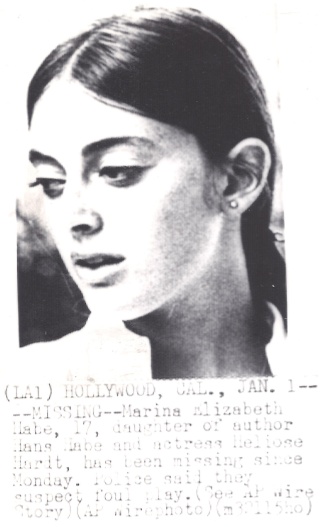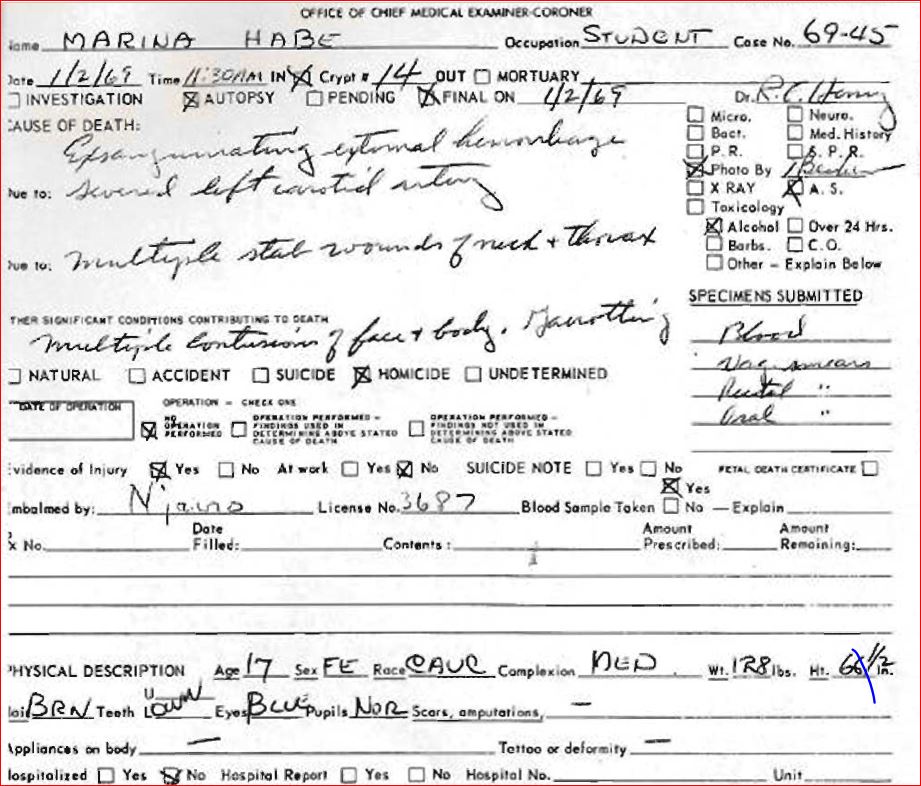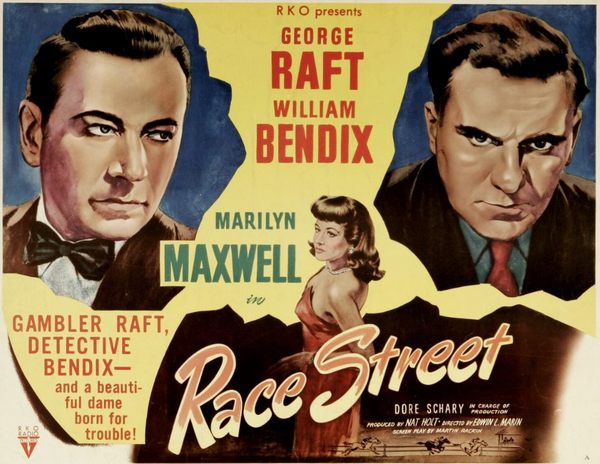 From the moment they entered the case, LAPD kept mum about the weapon used to batter Ramon Novarro to death. However, at trial the prosecution revealed the sad fact that Ramon was beaten with a cane, a memento from one of his films. It couldn’t have been more personal, nor more poignant.
From the moment they entered the case, LAPD kept mum about the weapon used to batter Ramon Novarro to death. However, at trial the prosecution revealed the sad fact that Ramon was beaten with a cane, a memento from one of his films. It couldn’t have been more personal, nor more poignant.
Deputy District Attorney James Ideman said he intended to show that Paul and Thomas Ferguson tortured Ramon to death while trying to find out where he hid his money. Ideman described how the 69-year-old former film heartthrob was beaten and then taken into a shower and revived so he could be questioned further.
The seven man, five woman jury listened to Ideman’s description of Ramon’s violent end at the hands of the young hustlers who accepted his hospitality, and then left him on his bed with his hands tied behind him, to drown in his own blood.

Photograph caption dated July 28, 1969 reads, “Paul Robert Ferguson confers with attorneys at opening of murder trial. Richard Walton, left, and Dorothy Montoya represented accused at beginning of jury selection.” [Photo & caption courtesy LAPL]
Forever in need of money, Paul telephoned Ramon on the day of the murder and introduced himself as a relative of Ramon’s acquaintance, Larry (Paul’s brother-in-law). Paul arranged to see Ramon that evening. He arrived with his brother Thomas and following dinner and drinks they demanded money. Ramon was wealthy, but never kept large sums at home, in fact, that night he had $45 in his wallet.
The prosecution’s case hinged on three points: (1) fingerprints, (2) the fact that it was impossible for Ramon to have written the name “Larry” with his hands tied and (3) Thomas’ telephone call to his girlfriend in Chicago from Ramon’s house.
As far as anyone could tell, the brothers intended to blame each other for Ramon’s murder. The main points in their strategy were: (1) blame the other brother and (2) mental illness.

Lawyer Cletus Hanifin, right, with murder suspects Tom (left) and Paul Ferguson. Photograph dated September 25, 1969. [Photo & caption courtesy LAPL]
Victor Nichols, a real estate investor and friend of Paul’s, testified that Paul and Thomas came to his Hollywood apartment after midnight on October 31. They weren’t trick-or-treating, they were in trouble. According to Victor, Paul said: “Vic, I’d like to see you . . . we are in some trouble. Tom hit Ramon . . . Ramon is dead.”
Victor gave Paul a cup of coffee to sober him up as Tom slept on the sofa. Victor’s guests made him nervous. He didn’t want to be involved in a murder. After Paul finished his coffee, Victor suggested he awaken Tom and leave. When Victor asked, “How could you do such a thing?” Thomas replied: “I hit him several times very hard and he is dead.”
Victor gave them $8 for cab fare and sent them on their way.
Paul took the stand and gave his version of the night of the murder. He said he went into Ramon’s bedroom and found him lying on the floor. He was covered in blood and his hands were tied behind him. “I touched him on the shoulder. He felt starchy . . . tight, like paper . . . “, said Paul.
From his chair at the defense table, Thomas starred daggers at his brother and shook his head as if he couldn’t believe the lies coming out of Paul’s mouth.
Paul claimed he wanted to phone the police, but Thomas vetoed the plan and suggested they stage a robbery. His attorney asked Paul why he would go along with Thomas’ plan, he answered, “Stupidness.”
Paul’s attorney asserted his client had no reason to kill Ramon because he thought the actor was a “nice guy”, and because Ramon said he might become a “superstar”. Paul said, “He (Novarro) said I could be a young Burt Lancaster or another Clint Eastwood.”
By the time Ramon met the Fergusons, Paul already had a minor career in the seedier side of show business. He was a nude model, and may have appeared in porno films. Ramon knew nothing about Paul’s career, but perhaps he saw a reflection of himself in the good looking younger man.

Paul Ferguson
The trial continued with the brothers blaming each other for the murder. Paul insisted he slept during the crime because he downed a fifth of vodka, some beer and tequila. Until Thomas awakened him and said, “This guy is dead” he was oblivious to Ramon’s screams and cries for help. How did Paul take the news of Ramon’s death? He said he was “just plain sad.” Thomas’ attorney asked Paul, “Why were you sad if you didn’t do it?”

Ramon in the tub.
“I was just sad because Ramon was dead . . . I had just had two weeks of bad luck and now I was thrown into this thing . . . I wanted to know why everything was happening,” Paul responded.
What was the bad luck plaguing Paul? His job sucked and his wife left him. Small problems compared to a man’s life. Paul admitted under oath that he considered suicide rather than face trial, but he rejected the idea. Asked why, Paul said, “I want to live.”
Neither Paul nor Thomas would admit to the murder, each blamed the other. There was some evidence to suggest Thomas was pressured by Paul and his mother to take the blame and he gave it a half-hearted try. As a juvenile he could not be sentenced to death.
On Wednesday, September 17, 1969, Paul and Thomas Ferguson faced the jury. If the plan was to save Paul from the gas chamber, it worked. Paul and Thomas received life sentences for first degree murder.
Prison agreed with Paul. Maybe it provided the structured environment he lacked on the outside. He was on the prison’s radio station and found his voice through creative writing. In 1975, he won a P.E.N. award for a short story, “Dream No Dreams.”
Thomas’ incarceration did not go well. He was constantly in trouble and spent much of his time in solitary for attempted escapes and other infractions of prison rules. It is easy to get drugs in prison, and Thomas got strung out on coke and glue.
Paul and Thomas never saw or spoke to each other again after they were released in 1976.
Parole wasn’t the start of a new life for either brother. Thomas was busted for rape in 1987. He spent four years in prison. When he did not register as a sex offender he was busted again. On March 6, 2005, Thomas went to a Motel 6 and cut his throat. He didn’t leave a note.
By 2012, Paul was once again in prison. This time it was for rape. Unless he wins an appeal, he can look forward to 60 years in a Missouri prison.

 There were no obvious signs sexual assault. An autopsy, conducted by coroner Thomas Noguchi, determined Marina’s cause of death as exsanguination and found no evidence of rape. The small amount of cash in Marina’s wallet seemed to rule out robbery as the cause of her abduction and murder.
There were no obvious signs sexual assault. An autopsy, conducted by coroner Thomas Noguchi, determined Marina’s cause of death as exsanguination and found no evidence of rape. The small amount of cash in Marina’s wallet seemed to rule out robbery as the cause of her abduction and murder. Her parents and 350 others mourned the pretty coed at her funeral. Marina converted to Catholicism in 1966 and they held a requiem Mass for her in the Good Shepherd Catholic Church in Beverly Hills. Father Acton, who knew Marina in life, said, “We wonder about a society, the products of which can be a large in our midst and capable of such heinous crimes. There you have the perfect formula for bitterness, resentment, hatred, perhaps despair. This we must guard against.”
Her parents and 350 others mourned the pretty coed at her funeral. Marina converted to Catholicism in 1966 and they held a requiem Mass for her in the Good Shepherd Catholic Church in Beverly Hills. Father Acton, who knew Marina in life, said, “We wonder about a society, the products of which can be a large in our midst and capable of such heinous crimes. There you have the perfect formula for bitterness, resentment, hatred, perhaps despair. This we must guard against.”






 From the moment they entered the case, LAPD kept mum about the weapon used to batter Ramon Novarro to death. However, at trial the prosecution revealed the sad fact that Ramon was beaten with a cane, a memento from one of his films. It couldn’t have been more personal, nor more poignant.
From the moment they entered the case, LAPD kept mum about the weapon used to batter Ramon Novarro to death. However, at trial the prosecution revealed the sad fact that Ramon was beaten with a cane, a memento from one of his films. It couldn’t have been more personal, nor more poignant.







 As the phone called neared an end, Thomas said, “Well, I better go now because I’m going to see what’s happening. . . I don’t want Paul to hurt Ramon.”
As the phone called neared an end, Thomas said, “Well, I better go now because I’m going to see what’s happening. . . I don’t want Paul to hurt Ramon.”
